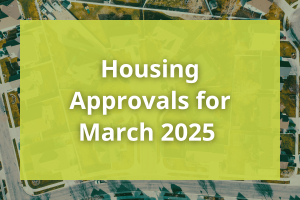Housing approvals fell 7.2% over the year-ended April 2017, continuing the decline of the last few months. At 219,982 separate approvals for the year, almost 18,000 less dwellings have gone through the approval processes than for the prior year. Demonstrating the decline is continuing, approvals for the month of April were down 2.1% compared with the prior April.
As the chart below shows, while approvals continue to decline from their incredible peaks of the second half of 2016, the end of this boom has yet to be met with an absolute bust.

To go straight to the dashboard and take a closer look at the data, click here.
The chart shows a full decade of Australia’s housing approvals. The chart has been provided this way to supply some perspective to the current decline.
The first observation is that the year-end peak reached in October 2015 (236,948 approvals) was followed by a remarkable year in which approvals plateaued, only commencing to dip 13 months later. The suspicion is that the plateau is, the result when all is said and done, of long pent up demand for housing, fuelled by record low interest rates and the change in the mix of Australia’s residential dwellings towards the smaller and multi-unit options.
Our second observation is that in historical context, this boom has been enormous. Normally that would send alarm bells. Big ascents are generally followed by crushing descents after all. But again, we can observe this does not seem to be the case. At least not yet. The chart shows that the long slow rise from October 2012 (when year-end approvals were 150,642) to the peak in October 2015 saw an average increase in approvals of 1.3% per month. Since the plateau ended in October 2016 (when year-end approvals were 229,336), the decline has been an average of just 0.9% per month.
It is true that the crunch may be yet to come. It might take only a couple of, currently unlikely, consecutive interest rate hikes to cruel approvals in some sectors, but at least for now, the decline in housing approvals is an orderly thing.
If it does happen that housing approvals slump at some point in the current downturn, we will not need to hunt too far for the culprit. The data also shows where the culprit is not. As the first chart also shows, approvals of free-standing houses continue to be stable – more so over the last two years than any other point in the decade displayed in fact.
For the year-ended April, free-standing dwelling approvals totaled 113,806, down just 2.8% on the prior year. They accounted for 51.7% of total approvals and have been growing their share continuously for seven consecutive months.
If the civil works on the outskirts of Sydney and Melbourne are anything to go by, free-standing houses are scheduled to continue their stability. That said, in April, approvals totaled just 7,831 separate houses, down 18.1% on the prior April. We must always be wary of a single month of data, but it reminds us to be watchful, if nothing else.
The culprit in the declining total housing approvals in Australia remains the multi-storey apartment buildings of 4+ Storeys. For the year-ended April 2017, approvals totaled 63,592 separate apartments. That is 14.2% lower than a year earlier, with evidence everywhere that the sector continues to soften at an appreciable rate.
We can see the comparative year-end declines, by dwelling type, in the chart below.

To go straight to the dashboard and take a closer look at the data, click here.
It remains a genuine shame – and an economic challenge – that 4+ storey apartment approvals are not further broken down, perhaps into 4 to 7 storey, 8 to 11 storey and 12+ storey groupings. That would allow for some separation of what are rapidly becoming quite distinct and diverse sectors.
We know that apartment blocks greater than 12 storeys (as an example), will be almost entirely within capital cities and pretty much concentrated around CBDs. But that is not the case of the mid-rise residential apartment blocks. Many of these are in the ‘urban infill’ class and are distinct in may respects from the large city apartments, including the materials used to construct them. For planning purposes, greater separation of apartments is required.
Regardless, what can be observed easily enough is that tall apartments are declining more rapidly than free-standing houses. No surprise there.
But what may be a surprise is the continued strength of the Semi-detached 2+ Storey dwelling approvals. Mid-density townhouse approvals are growing, while all else around them are wilting. In the year-ended April approvals totaled 24,154 separate residences, up 2.3% on a year earlier.
Rational, efficient land-use, largely around our inner-urban environments, brought about as old industrial sites are transformed into modern city living precincts are a major driver for the Australian housing market right now. What is most satisfactory about this trend, is that it appears to be consistent and stable. All indications are that it will continue for some time to come.



